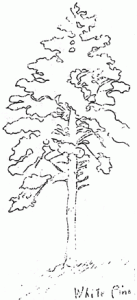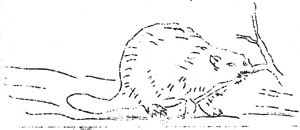Beavers in the Park
By D. S. Libbey
This season we are delighted to learn that within the area of Crater Lake National Park we have living colonies of the American Beaver (Castor Canadensis Pacificus), the national emblem of our sister nation to the north. It is the largest rodent on the continent and a member of the squirrel family which as adapted itself to life in the water.
Mr. Fred Patton, one of the oldest employees of Crater Lake National Park, called our attention to numerous beaver dams and fresh beaver cutting along the west margin of the park in the vicinity of Copeland Creek. Mr. Patton discovered the beaver activity while engaged in his work of opening a motor way.
Specimens of the fresh beaver cuttings have been placed on exhibit in the Community House and it is the plan to have guided motor caravans conducted to the scene of the activity by the ranger force. Also very careful efforts will be made to have the area adequately patrolled to preserve the colony of beavers and to prevent their extermination by poachers in the subsequent trapping season.
The pelt of the beaver is connected with the earliest exploration of North America, and fur trading in the days of the Old West was carried on extensively. Vast areas were discovered and developed because of the powerful incentive to seek out the beaver and obtain his pelt.
It is our goal to preserve our beaver friends. Their works have never ceased to be of perennial interest to man. So extensive the dam, so large the trees felled by no other tools than their chisel-like incisors, and so great the tracts of land flooded by the dams that the beavers have become known as the emblem of industry.
A beaver dam is never complete. The busy colony is constantly repairing it, adding fresh cuttings and shifting driftwood, stones and earth so that they are inextricably piled together. The obstructions create the pools of still water so desired by the beaver, and the cuttings from last winter show clearly the snow levels at which the animals were able to work.
The series of dams has materially changed the erosional activity of the creek and has resulted in basins which are splendid reservoirs for catching and preserving vegetable life which slowly decomposes and yields the necessary humus material. This results in offering favorable food supply for a more vigorous growth of flowers and trees which find their ideal habitat in a swamp.
The series of beaver colonies was found about the 5,250 foot elevation in the park.
A Challenge
By Frank Solinsky, Park Ranger
It is the ambition of most persons and corporations to hold a distinctive record of one kind or another. Nature has amply provided Crater Lake National Park with abundant material which, we believe, surpasses any similar phenomena to be found elsewhere. To continue in such a braggart tone is not congruent with the policy of the Park Service. Therefore, with an assumed modesty, we make public the facts concerning a gigantic tree.
This tree, a white pine (Pinus monticolae), stands in the east slope of the Middle Fork of Annie Creek. Measurements were taken in accordance with the Spaulding rule as provided in their log tables and revealed the following figures:
The circumference, breast height – 28 ft. 2 in.
The total height – 140 ft.
The tree is probably about 1,000 years old.
The Middle Fork, as do the rest of the creeks in the park, runs through a deep water and wind eroded canyon. The great age of this tree provides an unusual opportunity for the study of this erosion. The roots of the tree are well covered by soil and there is no indication of ground creep. On the other side of the canyon, we find trees in various stages of subversion. Some have toppled down into the creek below while others, with their roots exposed, have the appearance of standing on stilts. The curvature of some of these trees indicates the presence of ground creep. The one-sided erosion of the canyon can be attributed to the creek which runs under the west slope.


